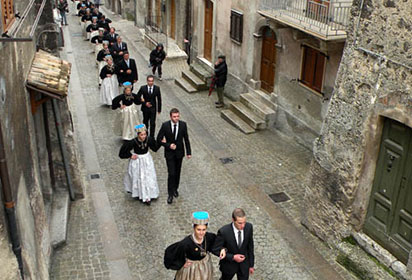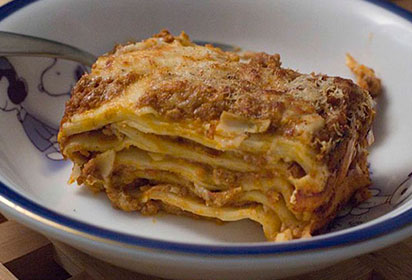From breathtaking, ancient hilltop towns, a little ragged around the edges, to Neolithic caves, Roman ruins, and the best beaches in the country, Abruzzo is as surprising and rare a find as an Egyptian tomb in a scoured desert.
Luciano Di Gregorio author of Abruzzo: The Bradt Guide
Abruzzo offers travellers a holiday that is as varied as its landscape, with snow-topped peaks, flower-swathed alpine meadows and remote beaches. Remote medieval villages and monasteries tumble down rugged slopes, villagers harvest saffron by hand in timehonoured fashion, and wolves and bears still lurk in forgotten corners. Yet fashionistas throng the streets of Pescara, and visitors flock to the region’s riviera to soak up the sun, gorge on seafood and live la dolce vita.
For more information, check out our guide to Abruzzo:
Food and drink in Abruzzo
Many visitors to Abruzzo, both Italian and foreign, claim that the food is one of the highlights of their stay. Indeed, many of the region’s fairs and festivals revolve around food, and eating is at the core of Abruzzo’s culture.
Eating out in Abruzzo is quite a simple and hassle-free aff air: the quality of food and drink will be good to excellent anywhere you go. This is especially true of smaller towns. Furthermore, Abruzzo has a fine culture of casual eating alongside proper dining. The food that you encounter at street kiosks and bars is almost always of great quality. In fact, when visiting a town or village, don’t hesitate to walk into a restaurant that looks more like someone’s kitchen or living room than a posh restaurant; your meal is likely to be even more memorable.
So it’s a lazy Sunday in Pescara, and you’re keen to make the most of the region’s gastronomic delights. Here’s how:
Breakfast
Get up early and head to your local bar. There is one at every street corner, so you probably needn’t go very far. Order a bomba and a cappuccino and do some people watching whilst sipping your coffee at the bar.
Lunch
Head to a restaurant, or, better yet, get invited to the home of a local. Here, enjoy a filling plate of sagne e fagioli. After your hearty meal, sip a genziana liqueur.
Afternoon snack
At about 17.00, take yourself to a pasticceria (patisserie) for an espresso accompanied by two pizzelle filled with a mixture of jam and chocolate spread such as Nutella, a snack favoured by the Pescaresi.
Dinner
Find a trattoria for the best arrosticini in the region. It is very common to eat at least 20 of these, accompanied by toasted bread with a dash of oil. Follow your meal with a saffron liqueur.
Vegetarians
Even though a recent survey claimed that 7% of Italians have become vegetarian, the idea hasn’t really penetrated the popular conscience yet, especially in the rustic Abruzzo. Though vegetarian restaurants exist, and many others in the cities can offer a vegetariano choice, in many places you’re going to be stuck with a lot of tomato and mozzarella salads.
As for vegans, if you tell an Abruzzese you are a vegano, chances are he won’t have the faintest idea what you’re talking about. But things are looking up; Abruzzo Vegan has a short list of vegan restaurants and food shops in the region (in Italian only).
Health and safety in Abruzzo
Health
Aside from the risks posed by exposure to the sun (both in summer and winter), and the nuisance of mosquitoes, health issues in Abruzzo are no different from those in other westernised countries.
In most cases, EU citizens with an EHIC (European Health Insurance Card) are entitled to free care in Italy from the SSN (Servizio Sanitario Nazionale, the national health system). Non-EU visitors will be expected to pay. Once you obtain an Italian residence permit, you are eligible to apply for the national health insurance.
There will be a hospital or clinic in every town of any size, and the staff in pharmacies are trained to assist with most minor problems. If one is closed when you need it, look for the card in the window with the schedule of the farmacia di turno (the closest one open).
Emergency numbers are the same throughout Italy.
Travel clinics and health information
A full list of current travel clinic websites worldwide is available on ISTM. For other journey preparation information, consult Travel Health Pro (UK) or CDC (US). Information about various medications may be found on Net Doctor. All advice found online should be used in conjunction with expert advice received prior to or during travel.
Safety
Whilst Abruzzo, as with most of Italy, is generally a safe place to travel, a sensible level of awareness is advised. This is particularly true in Pescara, where you should keep an eye on your belongings, especially in and around the station.
Female travellers
Women travelling alone or in small groups should not encounter any particular problems in Abruzzo, especially in the countryside. If possible, try to avoid arriving or leaving the stations of Pescara, Chieti, Teramo and L’Aquila too late at night. There have been problems and complaints in the past of things such as bag snatching, harassment, etc, though no more or less than in any other cities of similar size throughout Europe.
The beaches of coastal Abruzzo are generally a safe place for lone women to be. This is also true of the nightlife in and around the stabilimenti, which are often patrolled.
LGBTQ+ travellers
Attitudes towards gay, lesbian, bisexual and transgender people are consistent with those of the rest of Italy outside the bigger cities. A normal amount of discretion is advised. You are unlikely to be harassed in the provincial capitals, though the residents of country towns are likely to display a mixture of confusion and animosity, especially teenagers and the elderly. However, hotel workers are unlikely to question a gay or lesbian couple requesting a double room.
Pescara used to have its own gay nightclub, bar and sauna, but, following a recent spate of homophobic attacks on cars parked around the venue, this has since closed. There is a section of beach in the area of Scerne di Pineto which is frequented by many gay and lesbian people, especially on Sundays.
Despite some recent concerns, attitudes in Italy are slowly relaxing with a growing awareness of the issue of discrimination towards LGBT men and women which is discussed in both the media and politics. However, drastic change is unlikely to take place, given the pressures and influences of the Vatican City, a short distance (physically and metaphorically) from the central government in Rome.
Travel and visas in Abruzzo
Visas
Abruzzo is a region of the Italian Republic and therefore bound by all internal entry regulations, as well as those governed or required by the European Union and the Schengen Agreement. In addition to citizens of EU member states, holders of passports from some 50 nations do not need a visa for stays of 90 days or less. These include Australia, Canada, Hong Kong, Israel, Japan, Malaysia, Mexico, New Zealand, South Korea, Singapore, Switzerland, and the United States.
Theoretically, all foreigners are required to register their presence with the police within eight days of their arrival in the country, but in practice few people bother; in any case, your hotel should take your passport and residence details for this exact purpose. Note, however, that if you are non-EU and get in a jam with the police, they can take your failure to report your arrival as evidence that you have already overstayed the legal period.
EU citizens and their families (including grandparents, uncles and aunts, etc in some cases) can stay beyond 90 days if they have employment, sufficient resources to live by, or an approved course of study. Even so, it will require filling out a form at the local police station. Non-EU family members will need to apply for a residence permit, a carta di soggiorno. After five years EU citizens and family members have the right to a permanent residence card.
For citizens of non-EU countries, extending your stay in Italy beyond 90 days can be rather difficult; the first step is applying for a carta di soggiorno through the provincial Questura (state police office) or through the Post Office. Italy currently offers around 21 types of entry visa, few of which are entirely clear in their regulations and limitations, let alone in their explanation of what’s required in order to secure one. The most common types of foreign visa are those based on study, work and elective residence.
Whichever sort of visa or permit you need, expect the rules to be infernally complex, onerous and confusing. For detailed information on these subjects (in English), see the site of the Polizia di Stato, or that of the Foreign Ministry. Note that information on these two sites is often contradictory.
Getting there and away
By air
To Pescara
Abruzzo International Airport,10 minutes by bus from the centre of Pescara, is the main gateway to the region. Passenger numbers have risen by more than 400% over the last decade and an increasing number of international airlines are now using this small though often busy airport.
The city centre is only 3km away, reachable by taxi , by city bus 38, or the ARPA coach line, which continues on to Chieti.
To Rome
Many will find it more convenient to fly to Rome and travel from there to Abruzzo. Rome’s Fiumicino airport is a 2½-hour drive from the centre of Pescara and only 45 minutes from the border between Abruzzo and Lazio. Numerous international airlines from the UK, USA and elsewhere service the airport.
If you do not have your own transport, there are various options for getting to Abruzzo from Rome. The quickest is via the airport train terminal to Rome’s Tiburtina station. From there, buses are available to the larger cities such as Pescara. To travel on by train you must head for Rome’s Termini station. Be aware that while the bus journey takes around 2½ hours, the train can often take 4 hours.
Alternatively, Rome Ciampino airport is approximately 15km southeast of the centre of Rome. It is a major hub for both Ryanair and easyJet, so you may well find yourself arriving here. From the UK, there are flights from numerous regional airports as well as from London. To get to Abruzzo from here by public transport, it is necessary to make your way into the centre of Rome and out again by either train or bus from Tiburtina station. Should you wish to hire a car, you will find all of the major hire firms situated south of the departure hall.
By coach
A number of coach companies operate services from various European countries to Abruzzo. Check out BusWeb for information on services including times, prices and booking options.
By train
Travelling through Europe by train is an immensely rewarding way of reaching Abruzzo, and if you are coming from the UK it also means you can make stops along the way. Take the Eurostar across the Channel and connect with services to Italy.
Trenitalia, formerly known as the Ferrovie dello Stato, operates the country’s rail network. Pescara is a key stop for the Adriatic Frecciarossa express train linking Milan with the southern city of Bari, via Bologna and Ancona. Depending on schedules the Milan–Pescara trip takes 4–5 hours.
European rail passes are a great way to get around the continent and there are many different types. EURail provides a wealth of information on the various types of passes available. Trenitalia offers discount passes for over-60s (Carta d’Argento) and under 25s (Carta Verde). Be careful though – unless you intend riding an awful lot of trains, all these passes might not save you anything. Note that all the Freccia express trains (Frecciarossa, Frecciargento, etc) require a reservation, while regional trains do not; reservations are usually no problem, and come with the ticket you buy at the station. In Italy some city-centre travel agencies still sell Trenitalia tickets, which can be convenient. It is also possible to buy e-tickets online, or from ticket machines at the stations.
By ferry
Summer tourist car ferry services from Pescara to the Croatian island of Hvar (Stari Grad) are run by SNAV. Journey times to Hvar are around 3 hours, 45 minutes. Tickets can be bought online and at Pescara’s port, from where the ferries depart.
By car
Italy’s extensive network of motorways (autostrade) is well kept and equipped. It’s run by Autostrade per L’Italia who seem to put the money they rake in from the toll system to good use. It’s rare for Italians to fly domestically, though the increasing number of low-cost carriers is slowly changing this. Abruzzo is well serviced by autostrade. The A14, running straight through coastal Abruzzo, is the major Adriatic artery linking the southern city of Taranto with Bologna, from where it changes into the A1 to Milan and beyond. The A24 links Rome with the provincial capitals of L’Aquila and Teramo, while the A25 crosses the peninsula from Rome to Pescara. Use of the autostrade is tolled on a distance basis.
Car rental
Car hire companies with offices in the region are the same as you would expect to find anywhere else in Italy: Hertz, Avis, Europcar, Sixt and Maggiore, an Italian firm. Most of these have branches in all the major cities and towns, and at Rome’s Fiumicino/Ciampino airports.
Getting around
By car
Some parts of Abruzzo have sparse public transport connections so, unless you are visiting only Pescara, this is the quickest and most convenient way of getting around.
By bus
Buses are the method of public transport generally preferred by the Abruzzesi. Services, as elsewhere in Italy, are very good: comfortable, airconditioned, quick, regular, efficient and economical, especially to and from the four major cities and beyond, but also between the smaller provincial towns and villages.
ARPA is the Abruzzo’s main bus and coach company, and goes almost everywhere. ARPA shares the routes with other companies, including Di Febo Capuani and Di Fonzo. Don’t worry about the different companies. In practice, it generally works like one single bus line; the companies use the same stops and stations, and services are complementary. Information and schedules are available at the stations and tourist offices.
By train
Abruzzo, with its difficult terrain, is not particularly well served by trains. They can be very scenic, but the buses will almost always be cheaper and more convenient, and they reach far more destinations. As Abruzzo is on the main railway line connecting the Adriatic coast to the northern cities, travelling by train can make sense if you are moving between the coastal hubs. This coastal line has short branch services inland from Giulianova to Teramo, and San Vito-Lanciano to Lanciano. The other Abruzzo regional line connects Pescara to Rome, via Sulmona and Avezzano; from Sulmona you can change for L’Aquila (L’Aquila’s only rail service) and Terni in Umbria, or for Campobasso in the Molise.
By bicycle
Getting around by bicycle in the provincial capitals can be ideal – distances are relatively short. In Pescara, there is the added benefit of the strada parco (road through the park), which runs the length of the whole city between the Via Nazionale (the main thoroughfare through the city) and the Riviera. A disused railway line, the strada parco has been paved and is lined with trees and residential buildings.
Getting around the rest of the region by bicycle should not present a problem, although you should be aware that many country roads are in poor condition and will leave you wishing you had caught a bus instead. So, too, might the constant rolling hills right up to the coastline; you’ll need a certain level of fitness for longer bike trips.
When to visit Abruzzo
Abruzzo is, to coin an old travel cliché, a truly ‘year-round destination’, with ancient villages, castles, lakes and rivers nestling between soaring mountains that in the winter months offer some of the best skiing in the country – some of them only 30km from a pristine coastline.
Abruzzo’s climate is Mediterranean, with hot, dry summers and cold winters (especially in the region’s interior). However, each season has its own charm, not to mention a plethora of seasonal activities and sightseeing, no matter what the month. The spring and summer period bring pastel-coloured fields with red and purple flowers, an endless calendar of events in charming medieval towns with warm terracotta roofs and, of course, packed beaches. The months of July and August can often be relentlessly hot and dry for long periods, with daytime temperatures typically reaching 38–40°C. While travellers from places such as Australia will not find the sun as intense as back home, it is still powerful and protection is a must. Some years, it can be warm to hot as early as April and well into October.
During the colder periods, the region opens up to lovers of winter sports, especially during the months of December to February. Snow can fall as early as October and as late as April, and during midwinter it is bitterly cold in the higher mountains. Sunny winter days can be magical in the mountains and the snow gives the towns and villages a fairy-tale appearance.
What to see and do in Abruzzo
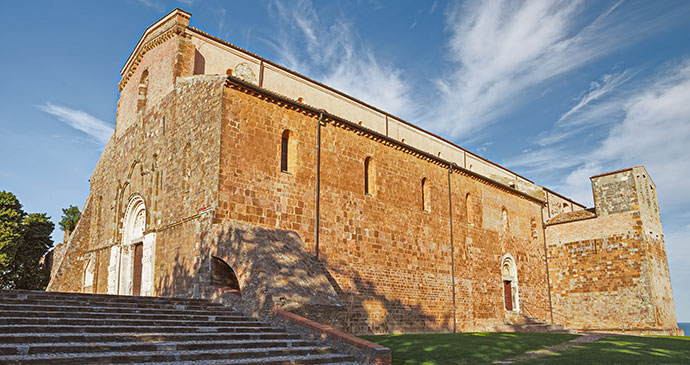
The abbey’s current structure was built in 1165 © Ermess/Dreamstime
Abbey of San Giovanni in Venere
This is one of the most famous and historically significant abbeys in Abruzzo. The current structure was built in 1165 but is said to have been constructed on the site of a Roman temple dedicated to Venus (hence its name, Venere, the Italian for Venus). Its location on a small olive-grove hill 100m from the coast and overlooking the Adriatic makes its situation just as appealing as the building itself.
The entrance into the abbey is through the famous Luna, or moon portal, decorated with some beautiful reliefs. On approach to the abbey, this door appears to be the side entrance but is actually the north-facing main doorway. The nave and its two aisles contain frescoes from the 12th–14th centuries. Some of these are particularly well preserved and vividly coloured, especially those in the crypt.
The abbey’s cloister (closed lunchtime, usually anywhere between 12.30 & 14.00) is perhaps even more attractive than the abbey itself. Its landscaped garden, with roses, palm trees and two tall conifers, is framed by charming lancet arches beneath bright, terracotta roof tiles.
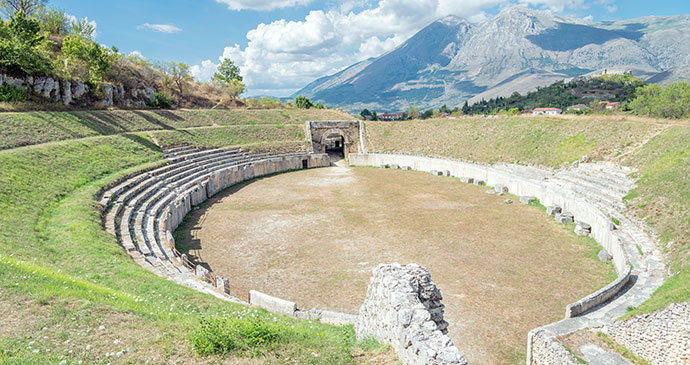
The ancient city of Alba Fucens is well preserved © Matteo Gabrieli/Shutterstock
Alba Fucens
If you take an interest in ancient Rome and its wonderfully convoluted history, Alba Fucens is a must-visit. Set on the hills and framed by the mountains of the Sirente Velino Regional Park, this wonderfully well-preserved ancient city is an easy place to imagine Roman citizens going about their business. Nowadays, the Roman, medieval and modern towns, all in close proximity to one another, show the various layers of settlement in Abruzzo.
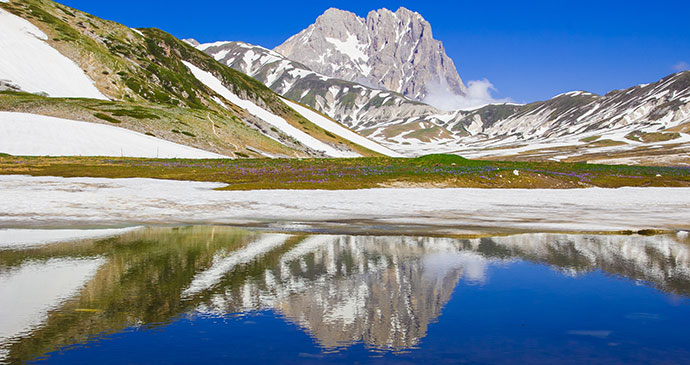
Campo Imperatore is overlooked by the tallest peak of the Gran Sasso National Park © Buffy1982/Shutterstock
Campo Imperatore
Campo Imperatore, sometimes called the ‘little Tibet’ of Italy, is a large plateau at over 1,500m above sea level. It is about 30km long and just under 10km wide, and is overlooked by the tallest peak of the Gran Sasso National Park, the Corno Grande. The area is most popular for its winter skiing, though it’s lovely to walk or drive here during the warmer months.
In 1943, Mussolini was imprisoned at what is now the Hotel Campo Imperatore. Please note that it is a complicated affair to drive around the area from around late October to March owing to heavy snowfalls. Many of the roads are cleared, but it is advisable to take great care and drive with wheel-chains.
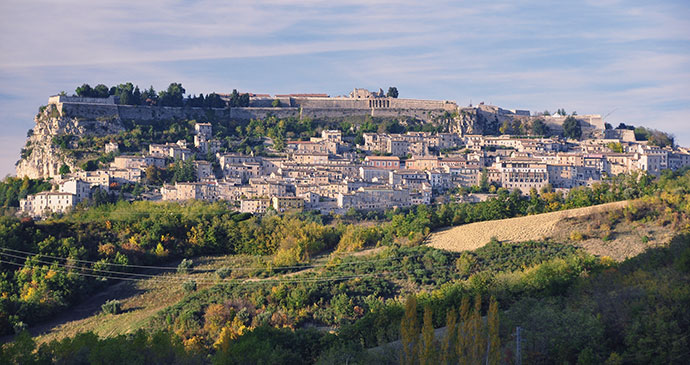
The town is famous for its fortress © Bornin54/Dreamstime
Civitella del Tronto
If you visit only one place in the province of Teramo, it should undoubtedly be the stunning town of Civitella del Tronto (population: approx. 5,000). It is a small, wall-enclosed gem about 650m above sea level and is famous for its impressive fortress, important from both an architectural and a historical point of view. The town has withstood long sieges, such as those instigated by the French in the 1550s and again during the Risorgimento (Italian unification). It was voted one of the most beautiful villages in Italy in 2012.
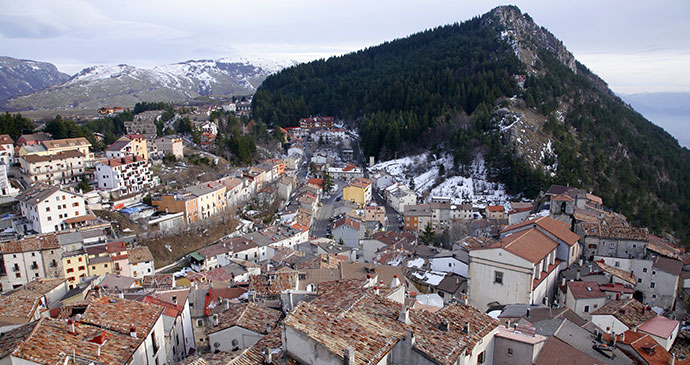
Ovindoli is a town of medieval origins © trotalo/Shutterstock.
Ovindoli
For more than a hundred years, this large town of medieval origins has been ‘the’ place in Abruzzo (if not in non-Alpine Italy) for skiing and snowboarding. During the colder months, Italians descend on Ovindoli with as much fervour as they would eat a gelato on a warm, July evening. In fact, the town’s popularity as a summer holiday destination almost rivals its winter tourism due to the beauty of the surrounding landscape. It is situated at the southern end of the Rocche plateau, which connects the Sirente and Velino massifs, and sits at more than 1,250m above sea level.
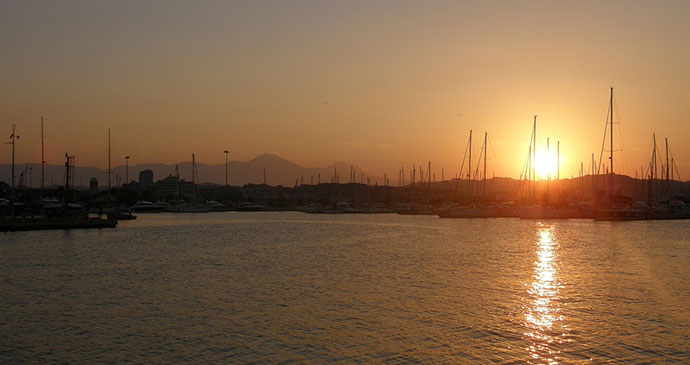
Pescara is especially charming in the warmer months © Ra Boe/Wikimedia-Commons
Pescara
Despite the obvious lack of evident history or historical landmarks, Pescara is a microcosm of some of the best things Italy has to offer: a dining scene to cherish, a summer atmosphere to knock your socks off, the best shopping in the region and a vibrant beach culture. As the economic powerhouse of Abruzzo, the city has been buffed and shined, and is ready to welcome the willing traveller with open arms.
During summer, Pescara has a knack for changing your outlook on what constitutes la dolce vita. The streets are awash with sunshine and are buzzing in the mornings and late afternoons, only to be found deserted and peacefully silent over the lunchtime and siesta hours. Nothing could be so important as to warrant shortening lunch, the most important meal of the day. Or, God forbid, missing out on those precious forty winks before heading back to work for the afternoon.
Whilst Pescara’s charms are not of the slap-in-the-face variety that are so common among the historical cities of Italy, it is a place well worth exploring, especially in the warmer months, when it really comes into its own. That said, it takes more than a moment or two to see past the concrete façades of the countless post-war apartment buildings to a vibrant, pastel-coloured coastal city that oozes rest and relaxation.
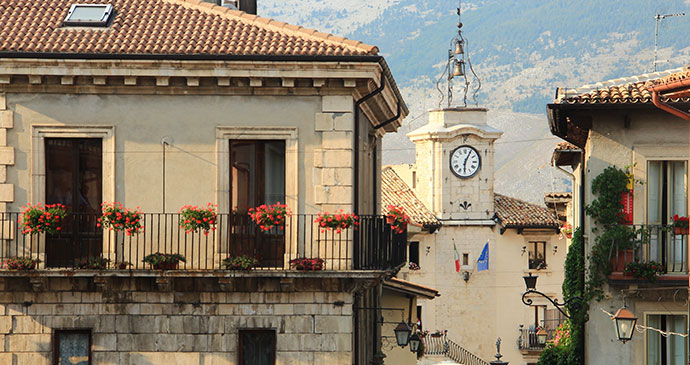
Pescocostanzo is strikingly beautiful © Giuseppe Di Paolo/Dreamstime
Pescocostanzo
Pescocostanzo is widely held to be one of the most striking towns in central Italy. Its architectural and artistic gems include centuries-old houses and public buildings, set on a peaceful plateau in a southern corner of the Majella National Park.
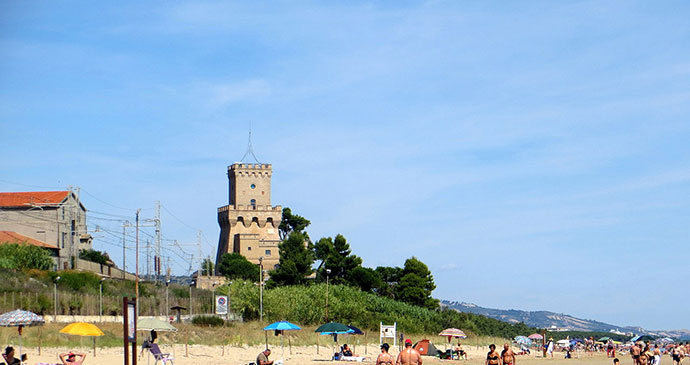
The beach at Pineto was awarded a Blue Flag in 2008 © Luca Aless/Wikimedia Commons
Pineto
The amiable town of Pineto is arguably one of the prettiest on the Teramo coast. Outside of the hectic summer season it is peaceful and an excellent place to lounge around and recharge your batteries. In 2008 its beach was awarded a Blue Flag, but it narrowly missed out in 2012.
Unlike in many other coastal towns here, the town does not extend to the coast itself, but is separated from the beach by a railway line and a pine grove (from which the town gets its name) planted by Luigi Filiani. This lack of beachfront development combines with the dry Mediterranean hills that frame the town to make it both attractive and serene.
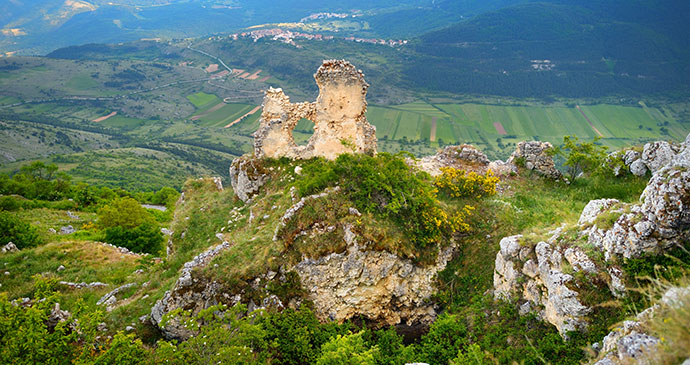
The Rocca Calascio Fortress is 1,500m above sea level © MNStudio, Dreamstime
Rocca Calascio Fortress
This great castle-fortress (admission free) is truly imposing and is perhaps one of the most magical sights in Abruzzo. Set at 1,500m above sea level, it’s the highest fortress in Italy and one of the highest in all of Europe. The exact date of construction is not known, but the castle (particularly the central tower) was reinforced in the mid 15th century. The stone fortress, a military stronghold, is notable for its symmetry and the quality of its construction, given the difficulties of building a castle in such an exposed and elevated location. The military reason for building a fort in this position was to give a sweeping view of Abruzzo, and it still has just about the best views to be had in the region, especially at dusk.
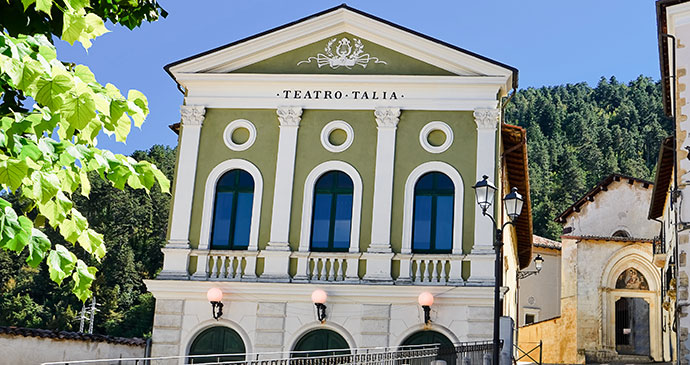
The Talia Theatre in Tagliacozzo © adamico/Shutterstock
Tagliacozzo
A picturesque town of serene lanes and alleys, Tagliacozzo is dotted with medieval and Baroque palazzi. One of the larger settlements in the area, it is renowned for its fairly intact medieval core. The town is not far from Abruzzo’s westernmost border with Lazio and is dramatically situated, as the name suggests (taglia means ‘cut’), cut sharply into the side of a hill. This means that its streets – most of which you’d not dare try to navigate let alone fit into by car – can be very steep, which makes the town all the more captivating.
Related books
For more information, see our guide to Abruzzo:
Related articles
Scanno is particularly well known for its traditional costume.
From pasta to pizza and everything in between, Abruzzo is a paradise for foodie enthusiasts.
